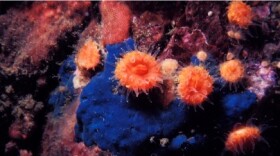http://www.youtube.com/watch?v=0lWbcT5gfY0
Crews have blasted a hole in a nearly century-old hydropower dam in Washington's south Cascades today, marking another step in efforts to restore habitat for threatened and endangered fish in the Pacific Northwest.
The more than 12-story Condit Dam on the White Salmon River is the second-tallest dam to be demolished in U.S. history.
Important day for fish, community
Its two turbines produce about 14 megawatts of power, enough for 7,000 homes, but its owner, Portland, Ore. based utility PacifiCorp, elected to remove the dam rather than install cost-prohibitive fish passage structures that would have been required for relicensing.
"This is a very important day for the river and the community," said Amy Kober, spokeswoman for advocacy group American Rivers. "We're not just talking about restoring vital fish runs in the region but improving a nationally renowned whitewater area."
The White Salmon River winds from its headwaters on the slopes of Mount Adams through steep, forested canyons to its confluence with the Columbia River, the largest river in the Pacific Northwest.
The 125-foot Condit Dam, which was built in 1913, blocked fish passage for native species of Pacific salmon and other anadromous fish that mature in the ocean and return to rivers to spawn, confining them to the lower 3.3 miles of the river.
Removing the dam and restoring a free-flowing river will open up miles of new habitat for fish and likely create additional recreational opportunities for kayakers and rafters in a region already known among whitewater enthusiasts.
Yakima Nation 'paradise'
Local residents who supported the dam's removal plan to join conservation groups and recreation enthusiasts at whitewater guiding company Wet Planet to watch a live Internet feed of the dam being breached.
Similar celebrations are being held at the Yakama Nation and at the Spring Creek National Fish Hatchery, where Emily Washines plans to display examples of willow fish traps, which would be used by Yakama tribal members in smaller creeks to catch fish.
Washines, a tribal member and remediation and restoration coordinator for Yakama fisheries, said she hopes young people will be able to once again use the traps in the White Salmon basin. Her grandfather, born in 1915, never saw the free-flowing river.
"My sister and I will be able to see the river the way our great-grandparents saw it," she said. "The resurgence of cultural activities and renewing a sense of what that means for our future generations is on the brink of happening."
Yakama Nation tribal elders have called the area a "paradise," recalling stories about tribal members fishing, hunting and gathering berries and other native plants before the dam was built. Tribal houses and drying sheds sat at the confluence with the Columbia for processing abundant salmon, steelhead and lamprey.
Restoring the habitat
Removal of the dam opens up at least 33 miles of habitat for steelhead. Habitat for tule fall chinook will double.
Yakama Nation chairman Harry Smiskin likened the return of fish to the river's upper stretches to "welcoming back a relative that has been missing for many years."
"It is sad that the dam is coming out, but again, it is a return to something our Creator, our Mother Nature, created for us and to put it back to as close to its natural state as it can be," he said.
The 5-story wedge of silt
In recent weeks, work crews created a tunnel 18 feet wide and 13 feet tall in the base of the dam to allow water and sediment to pass through from the reservoir behind the dam once it is breached. Over the years, a five-story wedge of silt has collected in 92-acre Northwestern Lake, a popular recreation spot for boaters and the dozens of cabin leaseholders on the water's edge.
Fisheries biologists also captured and relocated 679 tule chinook from below the dam to the river above it to protect their redds, or spawning nests, from being inundated by sediment when the dam is breached.
PacifiCorp has estimated the dam removal project at $32 million, far less than the $100 million improvements and fish ladders that would have been required by federal regulators to relicense the dam.
Fish ladders were incorporated on the dam when it was first built, but storms twice tore down the structures.
In the largest dam removal project in U.S. history, workers last month began removing the 210-foot Glines Canyon Dam and the 108-foot Elwha Dam from the Elwha River, part of a three-year $325 million project to restore the Olympic Peninsula river and its salmon runs.
On the Web:





